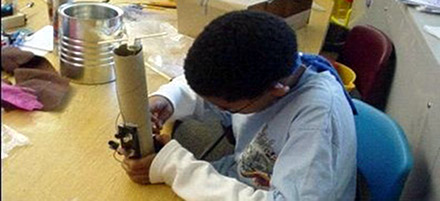
Wk 5: Constructing the Invention

Learning Outcomes:
- The learner will construct his/ her invention using the invention design, previously created in the student’s Invention Log.
Standards:
- National Science Education Standards, Students Kindergarten – Fourth Grade
-
- Content Standard E
-
- Students will develop an understanding of the abilities of technological design
- Identify a problem
- Propose a solution
- Implement a solution
- Evaluate a product or design
- Communicate a problem, design, and solution
Assessment:
- During the construction of the invention, the teacher will be looking to see that the student is utilizing and following the Invention Design that was previously created in the “Inventor’s Log.”
- While constructing, the teacher should informally interview each student. The teacher will ask:
-
- How are you using your design plans to help you construct your invention?
- What modifications have you made to your invention and why did you make them?
Introduction:
“Invention Convention” is an integrated project combining learning from language arts, science, and math curriculums allowing students to apply their understandings of magnets and electricity by designing or improving an existing invention.
Classroom Time Required:
- Time will vary, depending on the student and invention. A good estimate would be one to two hours.
Materials Need:
- Materials will vary, depending on the student and invention. Teacher and student should utilize the “materials list” outlined in the student’s “Inventor’s Log.”
Pre-activities:
- Prior to this lesson, students should have completed “Selecting an Invention,” “Designing an Invention,” “Material List,” and “Naming Invention” lesson.
- The teacher should have also received donations from families and ordered “engineering supplies” for students to utilize during construction. (List of engineering supplies can be found in the Needs and To Do’s column on the Invention Convention Timeline for Week 5.
Activities:
- The students will begin constructing their inventions. The teacher(s) should not touch the student’s invention, but should guide students with questions and suggestions. As much as is feasible, this should be the student’s work and creation. (When preparing teachers and adults to help with this process, we challenge adults to, “Help with hands behind their backs.”)
- Before students begin, remind them that they should be following the design they created in the “Inventor’s Log.” Explain that it is okay to modify the design, but it is not okay to construct a completely different design without following the design process.
Modifications:
- Because students are using a previously created drawing and are working with hands on materials, ELLs should be able to participate without modifications.
Supplemental Information:
Tips and Reminders
- Prior to beginning construction, decide and share with students whether students will be allowed to continue working on their inventions at home. The advantage to students working at home is there is more time and more adult to student attention. However, the disadvantage is that some students will receive extra supplies or direct adult help that other students do not have access to, making the process somewhat inequitable. (At my school, all invention work happens at school. We begin construction on the inventions following our state’s End of Grade tests. This allows meaningful instruction to continue in an engaging way, following three days of exams.)
- Outline a system for how students will choose and share the donated materials. Teachers need to ensure that there will be enough materials for all students.
- Teachers should make sure that students have a place to “store” their inventions while they are being constructed. Often, this requires a lot of space; so do not start the construction process any earlier than is necessary. Sometimes, it is best to have students store their invention in a box or bag with their name on it, while not in use.
- Students utilizing batteries should be reminded not to constantly “use” the battery, as it will quickly drain the battery. Teachers may want to set a “limit” on how many batteries each student will be supplied.
- Remind students that there will be times when they will need to stop and wait before moving on to the next part of construction. For example, any time students use glue, they will need to stop and wait for the glue to completely dry. Similarly, if the student is facing setbacks, it is often best to stop, think, and re-plan instead of continuing to altar the invention.
Supplemental Files:

